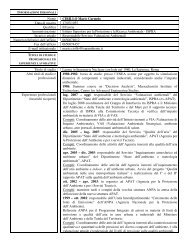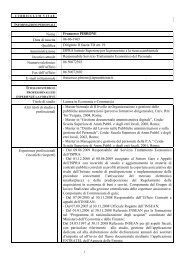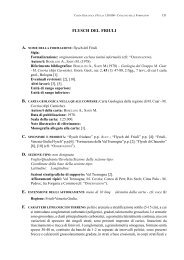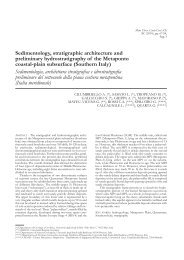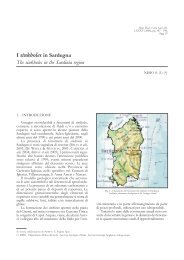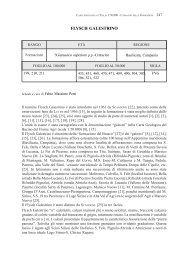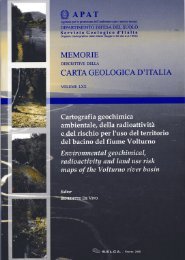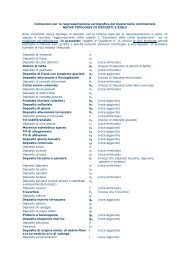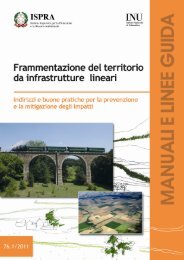Guidebook - Ispra
Guidebook - Ispra
Guidebook - Ispra
You also want an ePaper? Increase the reach of your titles
YUMPU automatically turns print PDFs into web optimized ePapers that Google loves.
Volume n° 1 - from PR01 to B15<br />
B12<br />
B12 -<br />
Leader: M. Sandulescu<br />
Stop 1.9:<br />
Breaza Ultramafic Tectonic Outlier (the visit of the<br />
Breaza tectonic outlier will be conditioned by the<br />
time and weather situation). Above the Wildflysch<br />
Formation of the northen sector of the Rarău Syncline,<br />
ultramafic rocks which represent a tectonic outlier of<br />
the Transylvanian nappes are developed (Săndulescu,<br />
1973; Săndulescu and Russo - Săndulescu, 1981). It<br />
is located in the axis of the syncline, which has an<br />
asymmetric shape in this area, with the external limb<br />
less developed than the internal one. On a left-hand<br />
tributary of the Moldova River, in Breaza, in front<br />
of the church, the following cross-section may be<br />
examined: on the first 300 m the Sinaia Formation<br />
of the Ceahlău Nappe (Tithonian-Neocomian calcareous<br />
flysch) crops out; it is overthrust by the metamorphic<br />
rocks of the Bucovinian Nappe, overlapped<br />
by Anisian dolomites and Callovian-Oxfordian (?)<br />
(or Ladinian?) “Radiolarite Beds”; the Wildflysch<br />
Formation, as a rule, represents the filling of the syncline.<br />
On the summits situated north of the brook the<br />
peridotites and serpentinites of the Breaza Tectonic<br />
Outlier crop out. This nappe outlier may be an equivalent<br />
of the Olt Nappe, which also contains ultramafic<br />
rocks of Ladinian/Carnian age. Further northward<br />
in the Păltiniș Summit conglomerates and coarsegrained<br />
sandstones of Cenomanian age are preserved<br />
from erosion. They seal the tectonic contacts between<br />
the Transylvanian and Bucovinian nappes and between<br />
the latter and the Ceahlău Nappe.<br />
The field-trip returns to Pojorâta and enters the Putna<br />
Brook (left tributary of Moldova River). Both slopes<br />
of the Putna Valley consist of metamorphic rocks of<br />
the Tulgheș Series, which belongs to the Bucovinian<br />
Nappe. At 4 km along the Putna Valley within a<br />
tectonic window the sedimentary formations of the<br />
Subbucovinian Nappe are exposed.<br />
Stop 1.10:<br />
Putna Valley Tectonic Window. The oldest formations<br />
cropping out are the Anisian dolomites. Thin red<br />
siliceous silts, possibly Ladinian, certainly Triassic,<br />
cover the dolomites. The youngest sequence known in<br />
the window are Lower Jurassic (according to the silicoflagellate<br />
assemblages) limonitic sandstones with<br />
blackish siltstone intercalations. The Subbucovinian<br />
sedimentary rocks are tectonically overlapped, at 50<br />
m above the brook, on its slopes, by the Tulgheș<br />
Series formations. Massive metamorphosed dolomites,<br />
which may belong to the Rebra Series, tectonically<br />
transported at the base of the Tulgheș<br />
Series, can be examined at the eastern border of the<br />
window. In the thalweg of the Putna brook, in front<br />
of a small tributary, a thin bank of graphite quartzites<br />
and schists crop out. The rocks belong to the “Median<br />
Complex” (Tg2) of the Tulgheș Series. Descriptions<br />
after Kräutner in: Sndulescu et al., 1981. The western<br />
border of the window is a vertical fault with a displacement<br />
of about 500 m (controlled by a borehole<br />
situated 100 m west of the fault). The borehole was<br />
drilled in the Bucovinian Nappe and reached the Subbucovinian<br />
Anisian dolomites.<br />
The fieldtrip continues upstream, westward. At the<br />
Valea Putnei Railway Station the erosional contour<br />
of the Bucovinian Nappe is stressed by the tectonic<br />
superposition of the metamorphic formations of the<br />
nappe above the Subbucovinian sedimentary formations<br />
which shows the same lithostratigraphic succession<br />
as in the Valea Putnei Tectonic Window.<br />
In the Mestecăniș Pass (1083 m in altitude), which is<br />
reached 5 km west of Valea Putnei Railway Station, a<br />
beautiful view opens out on the Bistriţa Mts. and the<br />
Bistriţa Aurie Valley, where the deepest Central East<br />
Carpathains unit, the Iacobeni Nappe, the highest of<br />
the Infrabucovinian nappes crops out within a tectonic<br />
window.<br />
From the Valea Putnei Railway Station up to<br />
Mestecăniș Pass and from there down until the western<br />
margin of the Mestecăniș Village, the road crosses<br />
the Tulgheș Series of the Subbucovinian Nappe.<br />
Stop 1.11:<br />
Puciosu Valley Cross Section.<br />
Along the national road, which runs on the righthand<br />
slope of Puciosu Brook, the basal sequence<br />
of the Subbucovinian Nappe and the sedimentary<br />
formations of the Iacobeni Infrabucovinian nappe<br />
are exposed. Upstream-downstream it is possible to<br />
examine: (1) the Black Quartzitic Formation (TG2)<br />
of the Tulgheș Series of the Subbucovinian Nappe<br />
(Bercia et al., 1975) represented by sericitic-quartzitic<br />
and chloritic-graphitic schists, with two levels of<br />
black quartzites; thin intercalations of metabasalts<br />
or limestones and calcschists, are known, south and<br />
north of Puciosu Brook. The black quartzites mark the<br />
level of syngenetic manganese ores, which consist of<br />
Mn-carbonate and silicates, enriched in Mn-oxydes in<br />
the oxidation zone. The principal mines are located<br />
some kilometers southwards; (2) the “Argestru Formation”<br />
(see also below), built up of metapsammites<br />
and phyllites with intercalations of metabasalts; (3)<br />
weak bituminous (“stinking”) Anisian dolomites




